Philly just got its first public statue of an African American girl
Philadelphia is known for having the largest public art collection, but there are few sculptures dedicated to an African American.

The girl, of middle-school age, is 5 foot 4 inches tall, seemingly contemplating where to make a pass. Strong legs set apart, she holds a basketball sharply to one side.
Sculpted from bronze, she is the first commissioned statue of an individual African American girl to join the city’s array of about 1,500 public sculptures, very few of which depict females.
The statue, MVP, was unveiled Wednesday morning at the Smith Playground and Recreation Center in South Philadelphia.
Brian McCutcheon, an Indianapolis-based artist who lived in Philadelphia for 10 years, was chosen from a number of artists to create a work of art for the Smith Playground after the city’s Office of Arts, Culture and the Creative Economy sought proposals under its Percent for Public Art program.
It was his idea to sculpt an African American girl. He used Scottlynn Johnson, a 12-year-old who lives near his studio in Indianapolis, as his model. She also is a basketball player, he said.
"My first thought was to build a monument to the people who typically use the park,” McCutcheon told The Inquirer on Tuesday. “And with the politics of the day, and just thinking about how people of color are not represented in public art, it seemed a natural fit.”
“Originally, I wanted to model her after a younger version of Dawn Staley,” McCutcheon said of the North Philadelphia native who is head women’s basketball coach at the University of South Carolina, a three-time Olympic gold medalist, and a member of the Naismith Memorial Basketball Hall of Fame.
But city officials, he said, were reluctant to commission statues of the living.
McCutcheon said he researched the city’s sports history and decided that Ora Washington (1898-1971) would be the inspiration. Because the project was to be “site-specific” to Smith, he decided to make the figure a young girl similar to the users of the playground.
Washington excelled at both tennis and basketball. After moving from Virginia to Philadelphia, Washington first played for the Germantown Hornets, a women’s basketball team affiliated with the Germantown Y, then known as the “Colored YWCA.”
She later played professional basketball with the Philadelphia Tribunes, a team sponsored by the black-owned newspaper. And between 1929 to 1937, she won the American Tennis Association singles title eight times out of nine years.
From what McCutcheon learned from his research, Washington never got a chance to challenge the preeminent white woman tennis player at that time, Helen Wills Moody, who garnered eight Wimbledon singles titles, and many more titles during a career from 1922 to 1938. “From what I read, [Moody] refused to play against Ora Washington.”
Margot Berg, the city’s public art director, oversees the city’s Percent for Art program, which commissions new site-specific public art in city construction projects that cost more than $1 million.
“It was just a wonderful opportunity to monumentalize the idea of young girls and young African American girls to show them a hero” who is like them, Berg said.
The Smith Playground recently underwent major renovations and improvements to its football fields, basketball courts, and other buildings.
The statue — which McCutcheon said was commissioned for $25,000 — was placed at the site that once featured a fountain.
City officials have often boasted that Philadelphia has the most public art in the nation. But there are not many single standalone statues of African Americans. In recent years, there has been an effort to include more statues of women, African Americans, and other people of color.
» READ MORE: New York will address its monument gender gap by adding statues of women. What about Philly?
A Quest for Parity: The Octavius V. Catto Memorial was dedicated at City Hall in 2017. Before that, there was the Joe Frazier statue at Xfinity Live, erected in 2015, and Mother Bethel A.M.E. Church installed a statue of its founder, Richard Allen, on church property in 2016. There is the All Wars Memorial to Colored Soldiers and Sailors at 20th and the Parkway (erected in 1934 and relocated in 1994), said city spokesperson Randy Giancaterino.
There also is the Negro Leagues Memorial (2005), dedicated to black baseball players at Belmont and Parkside Avenues; a bust of Martin Luther King Jr., at Haverford and Lancaster Avenues (2009), and a statue of Julius Erving, Dr. J, once at the Spectrum (1989) and since relocated to Xfinity Live. Most of the black statues in the city are athletes.
McCutcheon, a Michigan native, said he has a strong connection to the city, having first come here in 1992, shortly after college for a residency at the University of the Arts. Then, after graduate school at the Cranbrook Academy of Art in Michigan, he did a fellowship at the Clay Studio and stayed in Philadelphia for 10 years, between 1995 to 2005. During that time, he taught at Tyler School of Art in Elkins Park, before it moved to Temple University’s main campus.
McCutcheon delivered MVP to Philadelphia in the back of his pickup truck.